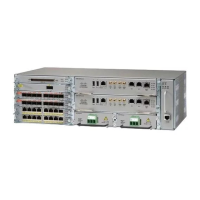Bridge Domain Interface with EFP, Sub-interface ▀
Cisco ASR 903 Router Design and Deployment Guide▄
The following rewrite can be implemented on Cisco ASR 903.
• Pop 1, remove one vlan tag
• Pop 2, remove two vlan tags
• Push 1, impose one vlan tag
With the above push and pop function, vlan 1 to 1, 1 to 2, 2 to 1, and 2 to 2 mapping can be achieved.
Bridge Domain Interface with EFP, Sub-interface
The Cisco ASR 903 router does not support sub-interfaces as on the other Cisco platforms but a workaround can
be used by pairing an Ethernet flow point (EFP) with a bridge domain interface (BDI).
• BDI is similar to SVI on the switch.
• At least one EFP must be associated with BDI to have line protocol up.
• EFP must make the packet native, one tag or two tags popping may be needed.
• Bridge-domain interface supports routing.
• Symmetric keyworld is required for push or pop operation.
The following shows an example how to create “sub-interface” off the interface of Gigabit Ethernet 0/2/0 on Cisco
ASR 903 router. The EFP will match encapsulation with vlan tag 10, pop the dot1q header in ingress direction,
forward the packet into bridge-domain 10 (think BD as Vlan domain as on the switch).
interface Gi0/2/0
! create an EFP instance
service instance 1 ethernet
encapsulation dot1q 10
rewrite ingress tag pop 1 symmetric ! pop is required to make packet native
bridge-domain 10
interface BDI10 ! BDI 10 is associated with bridge
ip address 10.10.10.1 255.255.255.0 ! domain 10
The above example is equivalent to the sub-interface on the other platforms. Note that Vlan command is not
required for create vlan to make BDI active on the Cisco ASR 903 router.
interface gigabitEthernet0/0/0/1.10
encapsulation dot1q 10
ip address 10.10.10.1 255.255.255.0
Ethernet Virtual Circuit using Regular EFPs
Here is a design example to provide end-to-end connectivity between CEs by using Ethernet bridging. For
illustration purpose, two subnets of A and B, are created to demonstrate connectivity. On CE1 router, vlan tag 10
and 11 are used; vlan tag 15 and 16 are used on CE2 router.

